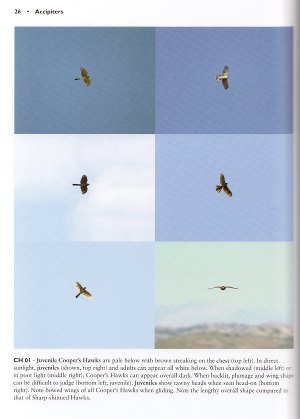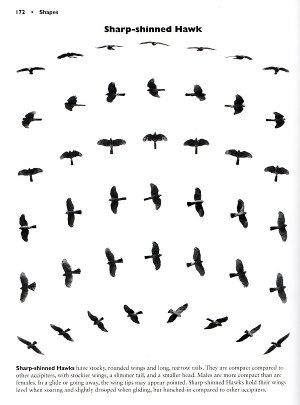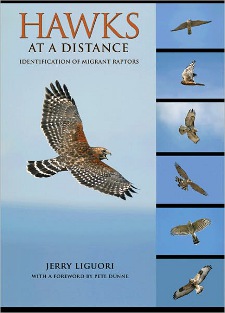Reviewed by Grant McCreary on May 4th, 2011.
Perhaps I shouldn’t admit this, but I’m still somewhat amazed that I’m able to identify most vultures at a glance while driving. Hawks still require a little more scrutiny but they’re not that bad, especially since raptor diversity is relatively low where I live. But hawk watchers? They’re a different breed altogether. I’ve read enough to know better, but being able to identify, much less age and sex, a hawk that’s no more than a speck on the horizon is akin to magic. It used to be that if you wanted to identify raptors like these experts you had to spend significant time with them at a hawk watch. Now, Jerry Liguori has condensed this expertise into Hawks at a Distance: Identification of Migrant Raptors.
There are already plenty of raptor identification books, but this book’s title intimates a unique approach. While other guides portray hawks up close with plumage-based field marks clearly visible, that’s not always how you see them. Many are far away and sometimes you only get a quick glimpse. Hawks at a Distance is designed to help birders identify these challenging birds.
And as the subtitle suggests, this guide focuses on the identification of migrant raptors. This makes sense, as you are more likely to see distant hawks from hawk watch spots in migration. Naturally, the information contained within will still be applicable to any hawk, not just those migrating. But there is one aspect that this focus greatly affects – species selection. Liguori gives full coverage to the 19 species most likely to be seen in migration in the United States and Canada, a slightly reduced account for one (Gyrfalcon), and abbreviated accounts for nine others. This means that some resident, range-restricted species are not covered (i.e. Harris’s Hawk, Snail Kite), though a few are (i.e. White-tailed Hawk, Hook-billed Kite).
 At the beginning of each full account you’ll find a full-page, gorgeous portrait of the hawk (the Rough-legged is especially nice). But those are the only “glamour shots” you’ll find; the rest of the photos in this book are drastically different. The birds don’t fill the frame – they are shown quite small and sometimes seem swallowed by sky or landscape. Some are in less-than-perfect lighting conditions, such as back-lit, shadowed, or over snow. One thing they all have in common is that every single photo here (most taken by the author himself) is of a bird in flight.
At the beginning of each full account you’ll find a full-page, gorgeous portrait of the hawk (the Rough-legged is especially nice). But those are the only “glamour shots” you’ll find; the rest of the photos in this book are drastically different. The birds don’t fill the frame – they are shown quite small and sometimes seem swallowed by sky or landscape. Some are in less-than-perfect lighting conditions, such as back-lit, shadowed, or over snow. One thing they all have in common is that every single photo here (most taken by the author himself) is of a bird in flight.
Looking through Hawks at a Distance is a completely different experience than with any other identification guide. You won’t be wowed by the photography, and in some cases you won’t be able to see the bird very well at all. The author has done this intentionally in order to “show raptors in ‘real world’ settings”.
Each identification plate includes three to six color photographs, with most arranged in three rows of two equally sized pictures. At the bottom of the page, following all the photos, is the caption. I normally don’t like arrangements like this, with the captions separated from what they’re describing. But it works here. The arrangement serves to give a better impression of how the hawk actually looks in the field, a concept this book shares with The Crossley ID Guide.
Besides the captions, there is, on average, a little more than a page of text for the full accounts and half a page for the others. The main text accounts give an overview of the identification of the species, focusing on that which is visible from a distance. Plumage receives the most attention, but shape is also prominent, and flight style is mentioned. Accipiters, buteos, and falcons also have a group overview.
 One of the best features of Hawks at a Distance is a section devoted solely to shape. A full page is devoted to each of the 19 raptors, where a multitude of photographs depict the bird in all kinds of postures, including head-on, gliding, soaring, and flying away. These plates are printed in black and white so as to focus attention on the shape, rather than plumage, of the birds.
One of the best features of Hawks at a Distance is a section devoted solely to shape. A full page is devoted to each of the 19 raptors, where a multitude of photographs depict the bird in all kinds of postures, including head-on, gliding, soaring, and flying away. These plates are printed in black and white so as to focus attention on the shape, rather than plumage, of the birds.
The relatively short introduction describes the book and how to use it; gives basic tips on identification, optics, and hawk counting; and includes a glossary, labeled photos for bird topography, and photos of raptors in various flight positions.
Hawks at a Distance nicely complements, rather than replaces, Liguori’s prior book, Hawks from Every Angle. There is some overlap, especially in the plumage descriptions, but the different approach of this new volume fills a gap in the coverage of the prior, making them together the complete guide to the identification of migrant raptors in flight.
Recommendation
In the introduction to their seminal Hawks in Flight, the authors write:
None of us will ever fully conquer that challenge [of identification of hawks in flight], because another raptor will always be coming along that is just a little bit farther away or a little higher – just slightly out of reach.
Twenty-two years later one of those authors, Pete Dunne, penned the forward to Hawks at a Distance in which he says: “Far. It’s not as distant as it used to be.”
Raptor fans, and especially anyone who spends time at hawk watches, will definitely want a copy of Liguori’s Hawks at a Distance. It’s quite simply the best guide to hawks at, well, a distance. But is it something that other birders will need? Maybe not need, as Hawks from Every Angle and Brian Wheeler’s raptor guides are sufficient for day-to-day birding. But since when is sufficient enough for birders? Hawks at a Distance will still be useful to any birder due to its different approach and the encouragement it gives to push the limits of our identification skills to the horizon (literally).
Disclosure: I get a small commission for purchases made through links in this post.
Disclosure: The item reviewed here was a complementary review copy provided by the publisher. But the opinion expressed here is my own, it has not been influenced in any way.





I love this book, it is a great idea done very well. Liguori keeps it simple but has lots of great information in there. I like Wheeler’s book but it really doesn’t help for field ID, it is more for studying plumage since all the photos are full frame and there are no black & whites or mannerism information. Hawks at a Distance is much better for learning hawks in the field.
Agreed. Wheeler doesn’t give the feel of the bird in flight like the Liguori books do. However, it does have some behavioral information. One tidbit that’s stuck with me is that Cooper’s Hawks will perch on posts while Sharpies never do. Not sure about “never”, but that’s proven helpful.